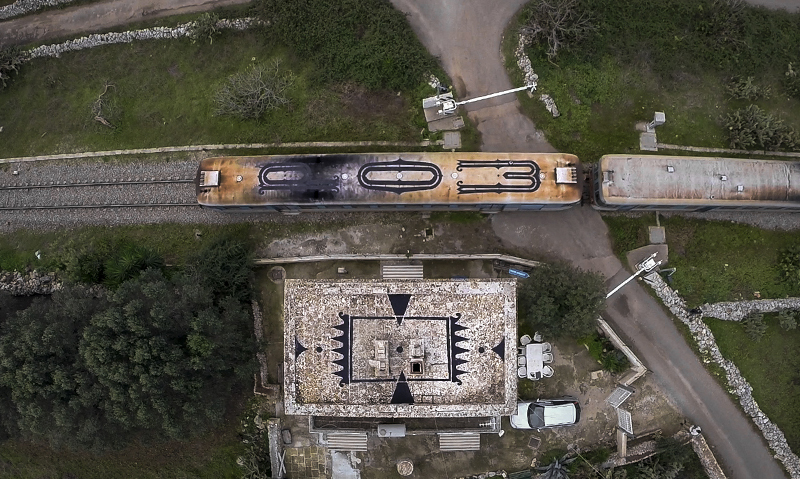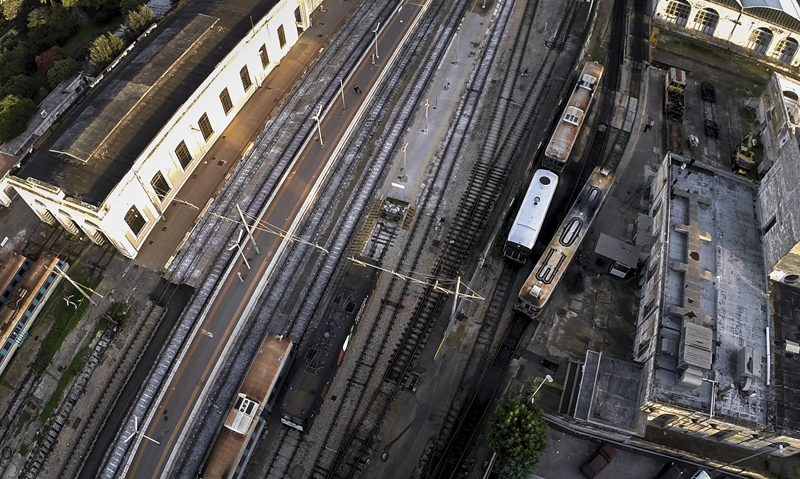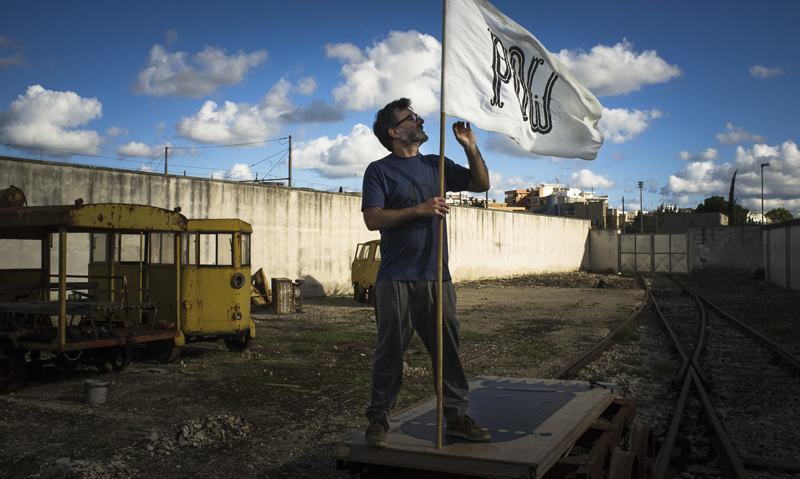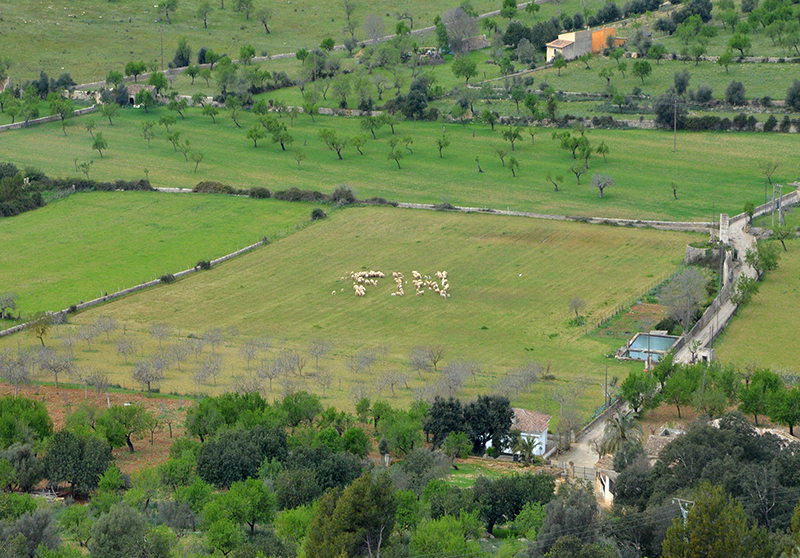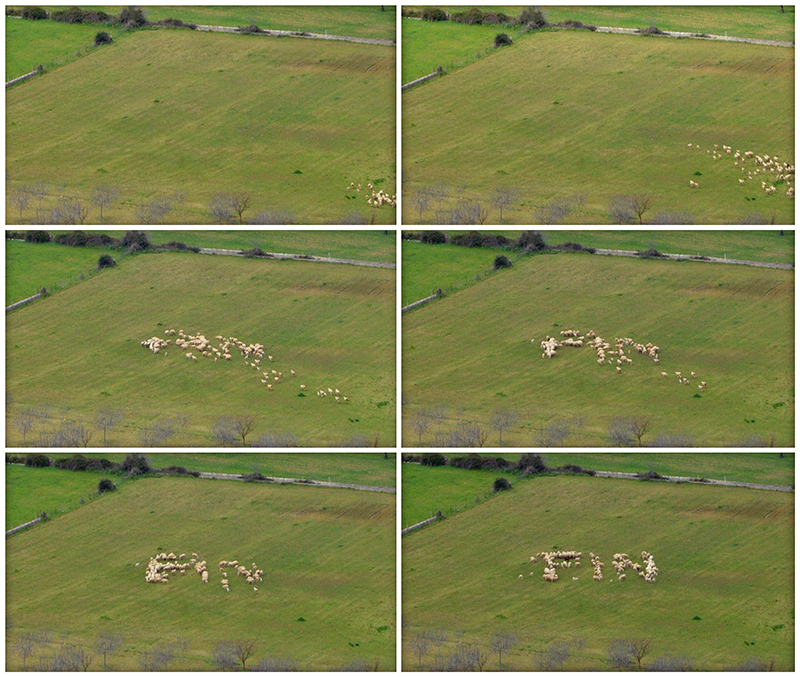Previous Art Projects
2013-2014
Prisoners Of War (POW)
Produced by PepeNero for PROGETTO GAP, Italy.
Curated by Francesca Marconi and Francesco Buonerba.
Local Management by Betta Patera.
︎
POW (Prisoners Of War) was the acronym written on the roofs of train carriages during the Second World War, to prevent them from being bombed by allied aircrafts.
But for ths artproject, POW - this time in a typical Salentino baroque typeface - has been placed on the roof of a train running on the regular Lecce-Maglie line. At a certain point, the acronym is aligned with its corresponding typographic cell, painted on the rooftop of the railway guard's house in Galugnano (Salento, Italy). The video shows this aerial alignment, between the moving target and the static viewer of the bomber, an alignment that occurs about 5 times a day.
POW is a specific art project designed to contrast the current majority use of the Italian Sud-Est railway network, by students and day labourers, with its previous use by soldiers and prisoners during the Second World War. It is therefore a project that investigates the contrast between cargo and surveillance, between historical memory and victorious discourse, between the past and the present of the bodies that cross the territory.
POW (Prisioners Of War) eran las siglas que se escribían en los techos de los vagones de tren durante la Segunda Guerra Mundial, para que no fueran bombardeados por los aviones aliados.
Pero para este proyecto, POW -esta vez en una tipografía típica del barroco Salentino- ha sido emplazado en el techo de un tren que recorre la línea regular Lecce-Maglie. En un determinado momento, las siglas se alinean con su correspondiente celda tipográfica, pintada en la azotea de la casa del guarda-raíles de Galugnano (Salento, Italia). El vídeo recoge dicha alineación aérea, entre el objetivo móvil y visor estático del bombardero, alineación que ocurre alrededor de 5 veces al día.
POW es un proyecto específico pensado para poder contrastar el actual uso mayoritario de la red ferroviaria Sud-Est italiana, por parte de estudiantes y jornaleros, con su anterior uso por parte de militares y prisioneros durante la Segunda Guerra Mundial. Es por tanto un proyecto que investiga el contraste entre la carga y la vigilancia, entre la memoria histórica y el discurso vencedor, entre el pasado y el presente de los cuerpos del territorio.
Produced by PepeNero for PROGETTO GAP, Italy.
Curated by Francesca Marconi and Francesco Buonerba.
Local Management by Betta Patera.
︎
POW (Prisoners Of War) was the acronym written on the roofs of train carriages during the Second World War, to prevent them from being bombed by allied aircrafts.
But for ths artproject, POW - this time in a typical Salentino baroque typeface - has been placed on the roof of a train running on the regular Lecce-Maglie line. At a certain point, the acronym is aligned with its corresponding typographic cell, painted on the rooftop of the railway guard's house in Galugnano (Salento, Italy). The video shows this aerial alignment, between the moving target and the static viewer of the bomber, an alignment that occurs about 5 times a day.
POW is a specific art project designed to contrast the current majority use of the Italian Sud-Est railway network, by students and day labourers, with its previous use by soldiers and prisoners during the Second World War. It is therefore a project that investigates the contrast between cargo and surveillance, between historical memory and victorious discourse, between the past and the present of the bodies that cross the territory.
POW (Prisioners Of War) eran las siglas que se escribían en los techos de los vagones de tren durante la Segunda Guerra Mundial, para que no fueran bombardeados por los aviones aliados.
Pero para este proyecto, POW -esta vez en una tipografía típica del barroco Salentino- ha sido emplazado en el techo de un tren que recorre la línea regular Lecce-Maglie. En un determinado momento, las siglas se alinean con su correspondiente celda tipográfica, pintada en la azotea de la casa del guarda-raíles de Galugnano (Salento, Italia). El vídeo recoge dicha alineación aérea, entre el objetivo móvil y visor estático del bombardero, alineación que ocurre alrededor de 5 veces al día.
POW es un proyecto específico pensado para poder contrastar el actual uso mayoritario de la red ferroviaria Sud-Est italiana, por parte de estudiantes y jornaleros, con su anterior uso por parte de militares y prisioneros durante la Segunda Guerra Mundial. Es por tanto un proyecto que investiga el contraste entre la carga y la vigilancia, entre la memoria histórica y el discurso vencedor, entre el pasado y el presente de los cuerpos del territorio.
Manual Of Equine Orthograph (MOEO)
Curated by Fernando Gómez de la Cuesta (Curatoria.org)
︎
MOEO is a site-specific art project about the culture of "TROTE" (horse racing typical of the Balearic Islands) through the orthopedics of movement and the concept of expanded drawing. A project that was developed between March and December 2014, and that was articulated from a performance carried out at the racecourse of Manacor (Mallorca): ten horses on a racecourse, at nine miles per hour, without haste and without certainty, drew their own orthography and, at the same time, also blurred the gaze of a human face, a symbol of mediation in the processes of cultural creation and destruction.
The MOEO exhibition brought together all the specific artwork developed in multiple video recordings, several installations and equine writing sculptures (customised crutches and odometers, occluders and custom-made eye charts) and dozens of laser engravings on cardboard (with the drawings created by the horses' feet on the racecourse).
Manual de ortografía equina (MDOE) es un proyecto de inmersión contextual en la cultura del TROTE a través de la ortopedia del movimiento y del concepto de dibujo expandido. Un proyecto que se desarrolló entre marzo y diciembre de 2014, y que se articuló a partir de una performance realizada en el hipódromo de Manacor (Mallorca): diez caballos, a nueve millas por hora, sin prisas, sin pausas y sin certezas, dibujaron su propia ortografía y, al tiempo, también desdibujaron la mirada de un rostro humano, símbolo de la mediación en los procesos de creación y destrucción cultural.
La exposición MDOE reunió todo el trabajo específico desarrollado en múltiples grabaciones videográficas, varias instalaciones y esculturas de escritura equina (muletas y odómetros personalizados, oclusores y cartas oculares a medida) y decenas de grabados láser sobre cartón (con los dibujos creados por las patas de los caballos en el hipódromo).
Curated by Fernando Gómez de la Cuesta (Curatoria.org)
︎
MOEO is a site-specific art project about the culture of "TROTE" (horse racing typical of the Balearic Islands) through the orthopedics of movement and the concept of expanded drawing. A project that was developed between March and December 2014, and that was articulated from a performance carried out at the racecourse of Manacor (Mallorca): ten horses on a racecourse, at nine miles per hour, without haste and without certainty, drew their own orthography and, at the same time, also blurred the gaze of a human face, a symbol of mediation in the processes of cultural creation and destruction.
The MOEO exhibition brought together all the specific artwork developed in multiple video recordings, several installations and equine writing sculptures (customised crutches and odometers, occluders and custom-made eye charts) and dozens of laser engravings on cardboard (with the drawings created by the horses' feet on the racecourse).
Manual de ortografía equina (MDOE) es un proyecto de inmersión contextual en la cultura del TROTE a través de la ortopedia del movimiento y del concepto de dibujo expandido. Un proyecto que se desarrolló entre marzo y diciembre de 2014, y que se articuló a partir de una performance realizada en el hipódromo de Manacor (Mallorca): diez caballos, a nueve millas por hora, sin prisas, sin pausas y sin certezas, dibujaron su propia ortografía y, al tiempo, también desdibujaron la mirada de un rostro humano, símbolo de la mediación en los procesos de creación y destrucción cultural.
La exposición MDOE reunió todo el trabajo específico desarrollado en múltiples grabaciones videográficas, varias instalaciones y esculturas de escritura equina (muletas y odómetros personalizados, oclusores y cartas oculares a medida) y decenas de grabados láser sobre cartón (con los dibujos creados por las patas de los caballos en el hipódromo).
︎ 03-12/2014 © Santiago Morilla
︎ Watch “MOEO” Single-channel Video Artwork (8:27)
︎ Watch “MAKING OFF MOEO” Single-channel Video Artwork (2:45)
![]()
![]()
![]()
![]()
![]()
![]()
![]()
![]()
![]()
︎ Watch “MOEO” Single-channel Video Artwork (8:27)
︎ Watch “MAKING OFF MOEO” Single-channel Video Artwork (2:45)
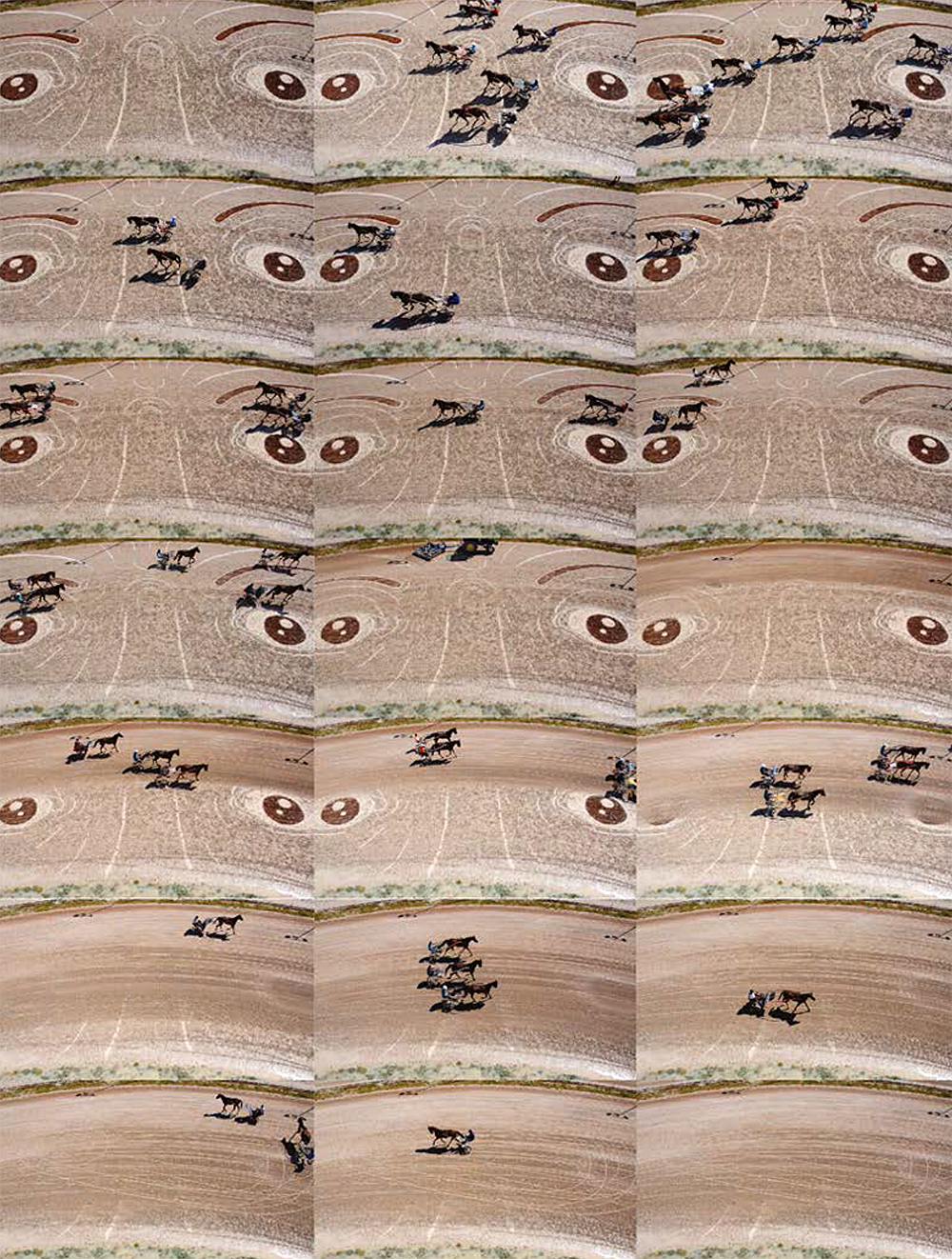





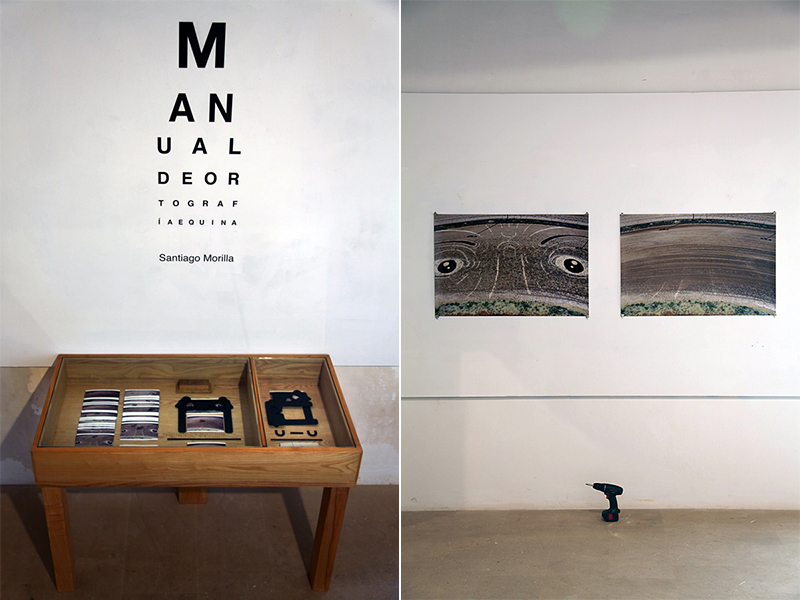


Invisible Bath
Technical support: Addaya Centre d'Art Contemporani, Alaró, Mallorca.
Editorial project curated by VB EXPOSICIÓN VISIBLE.
Curatorial text by Pau Waelder.
︎
In a reservoir located near the Cova de sa Font de ses Artigues, one finds the floating legs and penis of a character whose body, we imagine, is inserted into the side of the hill named Mola de Sa Bastida, in Alaró (Mallorca). "Invisible Bath" is a specific intervention made with Styrofoam tubes that form an infinite drawing that "hacks the landscape", swaying gently on the surface of the water. A drawing whose lower extremities symbolically filter all the irrigation of the nearby fields, but also, an intervention that is meant to be invisible: on one side, the chosen location is quite hidden; on the other, the drawing can only be properly seen from the air. And finally, this artwork is meant to be invisible because its existence is, as that of any living being, necessarily ephemeral.
“In Santiago Morilla’s interventions, bird’s eye view plays a determining role. Satellite view, which has always been the domain of the military and to which we now have access through the maps offered by Google and other companies, turns the land into a territory of control and domination. This is an unusual, unnatural point of view, which leads to an estrangement from what is being observed. At the same time, it is a perspective that shows us what we normally don’t see. Undoubtedly, Google Maps has enabled this tactic and detached view of the world to become commonplace, once again reshaping the boundaries of the fiction we call landscape. (…) This is what Santiago Morilla does in his intervention in the natural environment: he hacks the landscape, forces its limits. But he does so with a drawing and a site-specific intervention, which, when executed in the city, is often confused with so-called urban art. How does an intervention that can only be seen from the air modify the landscape? To what extent can we consider a structure of Styrofoam tubes, reeds and strings a drawing? Morilla’s action shows that, as Heyerdahl states, borders are only in people’s minds.”
(Extract from the text “HACKING THE LANDSCAPE" by Pau Waelder, published in the catalogue INVISIBLE BATH, 2013)
En un embalse situado junto a la Cova de sa Font de ses Artigues flotan las piernas y el pene de un personaje cuyo cuerpo, imaginamos, se introduce en la ladera de la Mola de Sa Bastida, en Alaró (Mallorca). "Baño invisible" es una intervención específica realizada con tubos de espuma de poliestireno que forma un dibujo infinito que “hackea el paisaje”, balanceándose suavemente sobre la superficie del agua. Un dibujo cuyas extremidades inferiores filtran simbólicamente todo el regadío de los campos cercanos, pero también, una intervención destinada a ser invisible: tanto por lo recóndito del lugar escogido, como por el hecho de que sólo puede verse correctamente desde el aire y finalmente porque este dibujo, como la existencia de las personas, es necesariamente efímero.
“En las intervenciones de Santiago Morilla juega un papel determinante la perspectiva cenital. La visión por satélite, que ha sido siempre dominio de los mandos militares y a la que ahora tenemos acceso gracias a los mapas de Google y otras empresas, convierte la tierra en territorio de control y dominación. Se trata un punto de vista atípico, antinatural, que nos proporciona un extrañamiento respecto a aquello que estamos observando. A la vez, se trata de una perspectiva que nos muestra aquello que normalmente no vemos. Sin duda, Google Maps ha facilitado que esta visión distanciada y táctica del mundo sea algo habitual, reconfigurando una vez más los límites de esa ficción que llamamos paisaje. (…) Esto es lo que lleva a cabo Santiago Morilla en su intervención en el medio natural: hackea el paisaje, fuerza sus límites, pero también lo hace con el dibujo y la propia idea de la intervención site-specific, esa que al realizarla en la ciudad se confunde con el llamado arte urbano. ¿Cómo modifica el paisaje una intervención que sólo puede verse desde el aire? ¿Hasta qué punto es un dibujo una estructura de tubos de espuma de poliestireno, cañas y cuerdas? La acción de Morilla nos demuestra que, como afirma Heyerdahl, las fronteras sólo están en la mente.”
Extracto del texto "HACKEAR EL PAISAJE" de Pau Waelder publicado en el catálogo Invisible Bath, 2013)
Technical support: Addaya Centre d'Art Contemporani, Alaró, Mallorca.
Editorial project curated by VB EXPOSICIÓN VISIBLE.
Curatorial text by Pau Waelder.
︎
In a reservoir located near the Cova de sa Font de ses Artigues, one finds the floating legs and penis of a character whose body, we imagine, is inserted into the side of the hill named Mola de Sa Bastida, in Alaró (Mallorca). "Invisible Bath" is a specific intervention made with Styrofoam tubes that form an infinite drawing that "hacks the landscape", swaying gently on the surface of the water. A drawing whose lower extremities symbolically filter all the irrigation of the nearby fields, but also, an intervention that is meant to be invisible: on one side, the chosen location is quite hidden; on the other, the drawing can only be properly seen from the air. And finally, this artwork is meant to be invisible because its existence is, as that of any living being, necessarily ephemeral.
“In Santiago Morilla’s interventions, bird’s eye view plays a determining role. Satellite view, which has always been the domain of the military and to which we now have access through the maps offered by Google and other companies, turns the land into a territory of control and domination. This is an unusual, unnatural point of view, which leads to an estrangement from what is being observed. At the same time, it is a perspective that shows us what we normally don’t see. Undoubtedly, Google Maps has enabled this tactic and detached view of the world to become commonplace, once again reshaping the boundaries of the fiction we call landscape. (…) This is what Santiago Morilla does in his intervention in the natural environment: he hacks the landscape, forces its limits. But he does so with a drawing and a site-specific intervention, which, when executed in the city, is often confused with so-called urban art. How does an intervention that can only be seen from the air modify the landscape? To what extent can we consider a structure of Styrofoam tubes, reeds and strings a drawing? Morilla’s action shows that, as Heyerdahl states, borders are only in people’s minds.”
(Extract from the text “HACKING THE LANDSCAPE" by Pau Waelder, published in the catalogue INVISIBLE BATH, 2013)
En un embalse situado junto a la Cova de sa Font de ses Artigues flotan las piernas y el pene de un personaje cuyo cuerpo, imaginamos, se introduce en la ladera de la Mola de Sa Bastida, en Alaró (Mallorca). "Baño invisible" es una intervención específica realizada con tubos de espuma de poliestireno que forma un dibujo infinito que “hackea el paisaje”, balanceándose suavemente sobre la superficie del agua. Un dibujo cuyas extremidades inferiores filtran simbólicamente todo el regadío de los campos cercanos, pero también, una intervención destinada a ser invisible: tanto por lo recóndito del lugar escogido, como por el hecho de que sólo puede verse correctamente desde el aire y finalmente porque este dibujo, como la existencia de las personas, es necesariamente efímero.
“En las intervenciones de Santiago Morilla juega un papel determinante la perspectiva cenital. La visión por satélite, que ha sido siempre dominio de los mandos militares y a la que ahora tenemos acceso gracias a los mapas de Google y otras empresas, convierte la tierra en territorio de control y dominación. Se trata un punto de vista atípico, antinatural, que nos proporciona un extrañamiento respecto a aquello que estamos observando. A la vez, se trata de una perspectiva que nos muestra aquello que normalmente no vemos. Sin duda, Google Maps ha facilitado que esta visión distanciada y táctica del mundo sea algo habitual, reconfigurando una vez más los límites de esa ficción que llamamos paisaje. (…) Esto es lo que lleva a cabo Santiago Morilla en su intervención en el medio natural: hackea el paisaje, fuerza sus límites, pero también lo hace con el dibujo y la propia idea de la intervención site-specific, esa que al realizarla en la ciudad se confunde con el llamado arte urbano. ¿Cómo modifica el paisaje una intervención que sólo puede verse desde el aire? ¿Hasta qué punto es un dibujo una estructura de tubos de espuma de poliestireno, cañas y cuerdas? La acción de Morilla nos demuestra que, como afirma Heyerdahl, las fronteras sólo están en la mente.”
Extracto del texto "HACKEAR EL PAISAJE" de Pau Waelder publicado en el catálogo Invisible Bath, 2013)
︎ 03/2013 - 04/2014 © Santiago Morilla
︎ Watch “Invisible Bath” Single-channel Video Artwork (3:56)
![]()
![]()
![]()
![]()
![]()
![]()
![]()
︎ Watch “Invisible Bath” Single-channel Video Artwork (3:56)


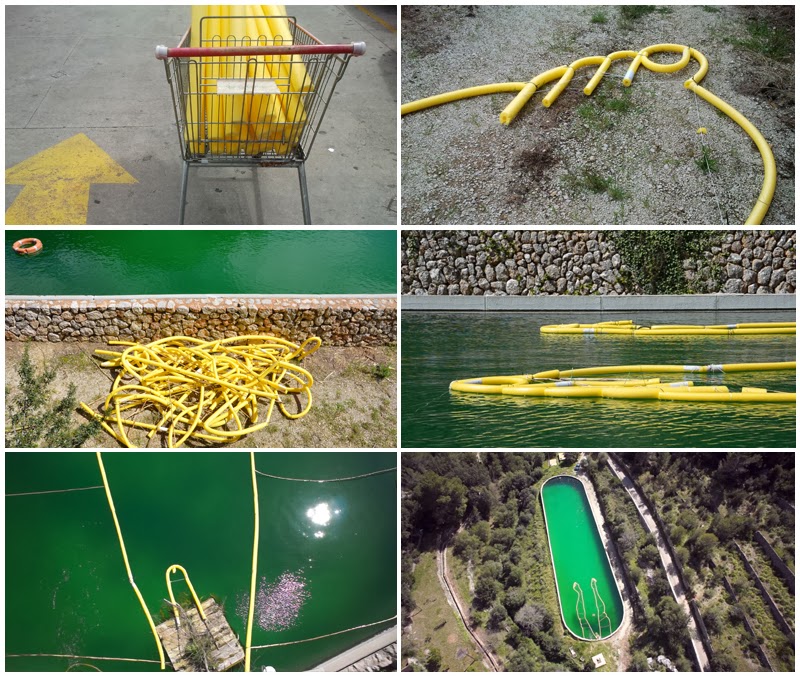




Index Falls
Curated by: Federica Forti / DATABASE CARRARA, Italy.
︎
“Santiago’s idea was to translate the classic iconography of pediments into a contemporary language, with the intent of both conserving its secular meaning (for our society itself is secular), and its architectural structure. In fact, the pediment constitutes the metonymy of a temple, its most important and specific part, by which the whole – the religious building in its entirety- may be referred to.
And if a pediment were to be built, as the artist has hypothesized, to decorate the temple of contemporary power through classic design (and not with a skyscraper, the contemporary temple of the Western secular and financial world), this temple of Imagined Power would be dedicated to the God of Finance, the artist believes. […] Would therefore have a pediment representing an inexistent, omnipresent and unnamed deity –after all, financial power is like this: it lacks an apex, yet is an oligarchy, which is not headed by a single sovereign but rather engulfs all our lives. The male and female figures forming the iconography of Morilla’s pediments (figures in free-fall following the iconography of the 9/11) are merely part of a mechanism of which they are both the supporting structure and sacrificial victim (composed according to the rhythms of INDEX rates)”
(Extract from the text “INDEX FALLS" by Federica Forti, published in the book INDEX FALLS, 2013)
“La idea de Santiago para el proyecto Index Falls fue traducir la iconografía de los frontones del arte clásico a un lenguaje contemporáneo, con la intención de conservar tanto su significado secular (porque nuestra sociedad es en sí misma secular), como su estructura formal y arquitectónica. De hecho, el frontón constituye la metonimia de un templo, su parte más importante y específica, por la que se puede referir al conjunto -el edificio religioso en su totalidad-.
Y si se construyera un frontón, para decorar el templo del poder contemporáneo mediante un diseño clásico (y no con un simple rascacielos, que bien podría ser el “templo contemporáneo” del mundo secular y financiero occidental), este templo del Poder Imaginado estaría dedicado al Dios de las Finanzas, según sostiene el artista. […] Tendría, pues, un frontón que representara a una deidad inexistente, omnipresente e innominada -al fin y al cabo, el poder financiero carece de una cúspide fija, pero sin embargo sí es una oligarquía, que no está encabezada por un único soberano, sino que engulle todas nuestras vidas, tiempos y energías. Las figuras masculinas y femeninas que conforman la iconografía de los frontones de Morilla (figuras en caída libre siguiendo la iconografía de los “falling men” que las Torres Gemelas el 11/S) no son más que parte de un mecanismo del que son a la vez estructura de soporte y víctima sacrificial (estructuras que están, además, compuesta según los ritmos de las gráficas de contización INDEX de las grandes empresas transnacionales)”
Extracto del texto "INDEX FALLS" de Federica Forti, publicado en el libro Index Falls, 2013)
Curated by: Federica Forti / DATABASE CARRARA, Italy.
︎
“Santiago’s idea was to translate the classic iconography of pediments into a contemporary language, with the intent of both conserving its secular meaning (for our society itself is secular), and its architectural structure. In fact, the pediment constitutes the metonymy of a temple, its most important and specific part, by which the whole – the religious building in its entirety- may be referred to.
And if a pediment were to be built, as the artist has hypothesized, to decorate the temple of contemporary power through classic design (and not with a skyscraper, the contemporary temple of the Western secular and financial world), this temple of Imagined Power would be dedicated to the God of Finance, the artist believes. […] Would therefore have a pediment representing an inexistent, omnipresent and unnamed deity –after all, financial power is like this: it lacks an apex, yet is an oligarchy, which is not headed by a single sovereign but rather engulfs all our lives. The male and female figures forming the iconography of Morilla’s pediments (figures in free-fall following the iconography of the 9/11) are merely part of a mechanism of which they are both the supporting structure and sacrificial victim (composed according to the rhythms of INDEX rates)”
(Extract from the text “INDEX FALLS" by Federica Forti, published in the book INDEX FALLS, 2013)
“La idea de Santiago para el proyecto Index Falls fue traducir la iconografía de los frontones del arte clásico a un lenguaje contemporáneo, con la intención de conservar tanto su significado secular (porque nuestra sociedad es en sí misma secular), como su estructura formal y arquitectónica. De hecho, el frontón constituye la metonimia de un templo, su parte más importante y específica, por la que se puede referir al conjunto -el edificio religioso en su totalidad-.
Y si se construyera un frontón, para decorar el templo del poder contemporáneo mediante un diseño clásico (y no con un simple rascacielos, que bien podría ser el “templo contemporáneo” del mundo secular y financiero occidental), este templo del Poder Imaginado estaría dedicado al Dios de las Finanzas, según sostiene el artista. […] Tendría, pues, un frontón que representara a una deidad inexistente, omnipresente e innominada -al fin y al cabo, el poder financiero carece de una cúspide fija, pero sin embargo sí es una oligarquía, que no está encabezada por un único soberano, sino que engulle todas nuestras vidas, tiempos y energías. Las figuras masculinas y femeninas que conforman la iconografía de los frontones de Morilla (figuras en caída libre siguiendo la iconografía de los “falling men” que las Torres Gemelas el 11/S) no son más que parte de un mecanismo del que son a la vez estructura de soporte y víctima sacrificial (estructuras que están, además, compuesta según los ritmos de las gráficas de contización INDEX de las grandes empresas transnacionales)”
Extracto del texto "INDEX FALLS" de Federica Forti, publicado en el libro Index Falls, 2013)
︎ 04-08/2013 © Santiago Morilla
︎ Watch “Index Falls: Carrara Marble Falls” Single-channel Video Artwork (3:10)
︎ Watch “Index Loops” Single-channel Video Artwork (1:04)
![]()
![]()
![]()
![]()
![]()
![]()
![]()
![]()
︎ Watch “Index Falls: Carrara Marble Falls” Single-channel Video Artwork (3:10)
︎ Watch “Index Loops” Single-channel Video Artwork (1:04)


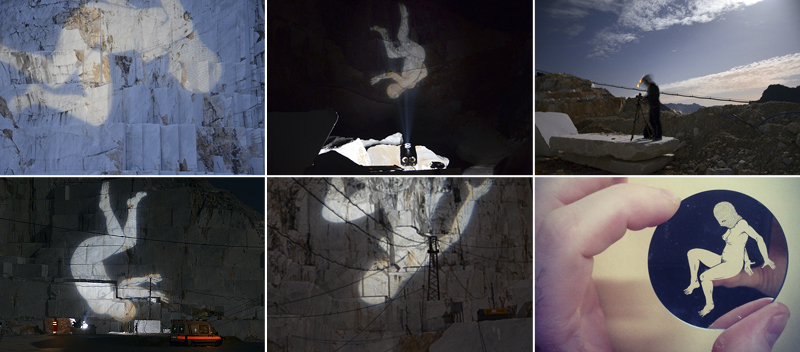





FIN (The End)
Produced and curated by Santiago Morilla.
Technical support: Addaya Centre d'Art Contemporani, Alaró, Mallorca.
︎
The word "THE END" (Fin, in spanish) is formed during a few seemingly accidental moments in which the collision between food, the movement of the sheep, the shared space and the timeline occurs (and disappears) in an endless loop. And perhaps, as in Homer's Odyssey, we humans camouflage ourselves under the sheep in order to - through cunning and collective organisation - escape the new Cyclops Polyphemus (who continues to play with inequality in the distribution of food and, by extension, with the distribution of wealth and power).
La palabra “FIN” se forma durante unos instantes aparentemente accidentales en los que la colisión entre la comida, el movimiento de las ovejas, el espacio compartido y la línea temporal se produce (y desaparece) en un bucle sin fín. Y es que, tal vez, como en la Odisea de Homero, los humanos nos camuflamos bajo las ovejas para –mediante la astucia y la organización colectiva– poder escapar del nuevo cíclope Polifemo (que sigue jugando con la desigualdad en la distribución de los alimentos y, por extensión, con la distribución de la riqueza y el poder).
Produced and curated by Santiago Morilla.
Technical support: Addaya Centre d'Art Contemporani, Alaró, Mallorca.
︎
The word "THE END" (Fin, in spanish) is formed during a few seemingly accidental moments in which the collision between food, the movement of the sheep, the shared space and the timeline occurs (and disappears) in an endless loop. And perhaps, as in Homer's Odyssey, we humans camouflage ourselves under the sheep in order to - through cunning and collective organisation - escape the new Cyclops Polyphemus (who continues to play with inequality in the distribution of food and, by extension, with the distribution of wealth and power).
La palabra “FIN” se forma durante unos instantes aparentemente accidentales en los que la colisión entre la comida, el movimiento de las ovejas, el espacio compartido y la línea temporal se produce (y desaparece) en un bucle sin fín. Y es que, tal vez, como en la Odisea de Homero, los humanos nos camuflamos bajo las ovejas para –mediante la astucia y la organización colectiva– poder escapar del nuevo cíclope Polifemo (que sigue jugando con la desigualdad en la distribución de los alimentos y, por extensión, con la distribución de la riqueza y el poder).
